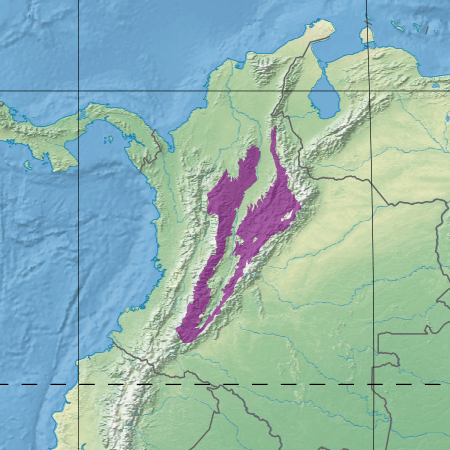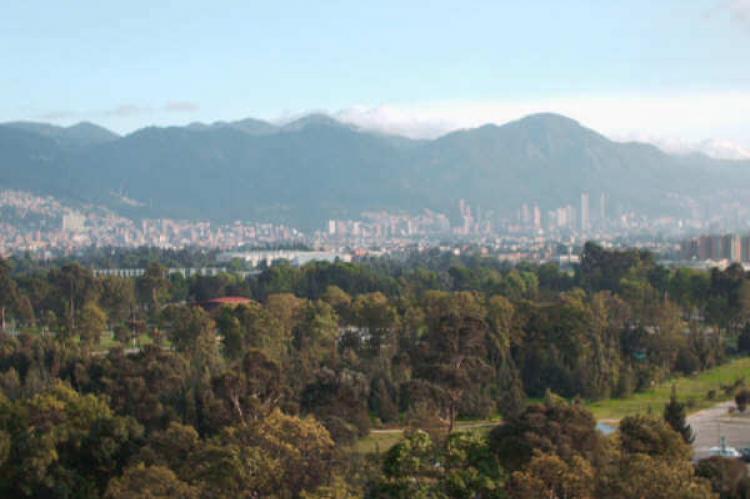Magdalena Valley Montane Forests Ecoregion (Colombia)
The Magdalena Valley montane forests ecoregion is located in the Andes mountains of central Colombia. The ecoregion covers the higher land on both sides of the valley of the Magdalena River in the Colombian Andes.
Magdalena Valley Montane Forests
The Magdalena Valley montane forests ecoregion is located on the inner slopes of the central and eastern cordilleras of the Colombian Andes. The ecoregion covers the higher land on both sides of the Magdalena River valley.
The climate here is seasonally wet. The rainy seasons occur between April and June and from October to December. A cloud forest belt forms at approximately 1,800 - 2,200 m (5,900 - 7,200 ft) and again at 2,800 - 3,200 m (9,200 - 10,500 ft).
The Magdalena River flows north between the Eastern Ranges to the east and the Central Ranges to the west, down to the Caribbean lowlands. The watershed drains through the Magdalena River and includes other important tributaries: the Suaza, the Saldaña, the Sumapaz, the Chicamocha, the Carare, the Cauca, and the Nechí.
The Magdalena Valley montane forests ecoregion encloses the Magdalena Valley dry forests, which contain the upper Magdalena River.
The Magdalena-Urabá moist forests contain the lower Magdalena River and extend across the lowlands north of this ecoregion.
The rocks of the Eastern Ranges are sedimentary in origin, while the Central Range is highly volcanic and metamorphic. As a result, soils are very diverse, giving rise to diverse flora.
Flora and Fauna
The montane forests that grow along the Magdalena River valley on the inner slopes of the Eastern and Central Cordilleras of the Northern Andes in Colombia are rich in animal and plant diversity and endemic species.
Common trees include Anacardium excelsum, Cedrela odorata, Cordia alliodora, Decussocarpus rospigliossi, Hieronyma macrocarpa, Jacaranda caucana, Juglans neotropica, Podocarpus oleifolius, Quercus humboldtii, Tabebuia rosea, Tabebuia serratifolia, Vochysia ferruginea and palms such as Ceroxylon alpinum, Ceroxylon quindiuense, Ceroxylon parvifrons, Ceroxylon sasaimae, Ceroxylon vogelianum and Dictyocaryum lamarckianum.
The wax palms (Ceroxylon) species are of particular concern. In addition, the Andean rosewood (Aniba perutilis) is endangered.
Endemics in the hilly areas along the cordilleras include Ceroxylon sasaimae, Heliconia abaloi, Heliconia estiletioides, Heliconia huilensis, Heliconia laxa, Heliconia mutisiana, Heliconia oleosa, Heliconia reptans and Odontoglossum crispum.
Endemic orchids include Cattleya trianae in the upper Magdalena and Cattleya warscewiczii in the San Lucas - Nechi region.
Other common orchids include Masdevallia coccinea, Miltoniopsis vexillaria, Odontoglossum crispum and Odontoglossum nobile. In addition, Colombia's national flower, the Christmas orchid (Cattleya trianae), is endangered.
Large vertebrates include the cougar (Puma concolor), oncilla (Leopardus tigrinus), spectacled bear (Tremarctos ornatus), Geoffroy's spider monkey (Ateles geoffroyi), brown woolly monkey (Lagothrix lagothricha), South American tapir (Tapirus terrestris), mountain tapir (Tapirus pinchaque), little red brocket (Mazama rufina), pacarana (Dinomys branickii), mountain paca (Cuniculus taczanowskii) and Venezuelan red howler (Alouatta seniculus). The brown woolly monkey, mountain tapir and spectacled bear are of particular concern.
Endangered mammals include the black-headed spider monkey (Ateles fusciceps), red-crested tree-rat (Santamartamys rufodorsalis), Handley's slender opossum (Marmosops handleyi), white-footed tamarin (Saguinus leucopus) and mountain tapir (Tapirus pinchaque).
Endangered reptiles include Daniel's large-scale lizard (Ptychoglossus danieli) and Colombian lightbulb lizard (Riama columbiana).
Protection Status
The World Wide Fund for Nature (WWF) gives the Magdalena Valley montane forests ecoregion the status of "Critical/Endangered." The region is home to over 70% of the population of Colombia.
The slopes are used for farms and coffee plantations on a large scale, leaving little intact habitat other than fragments of forests. Unfortunately, the destruction of these fragments continues, although a movement exists to improve conservation.
The best-preserved areas are the upper Magdalena around the Los Guacharos National Park, Nevados del Puracé and Huila slopes, and the Serranía de San Lucas. The remaining regions have forest fragments of variable size.

Map depicting the location of the Magdalena Valley montane forests (in purple)
